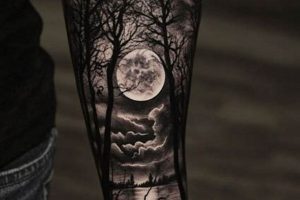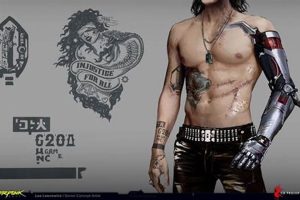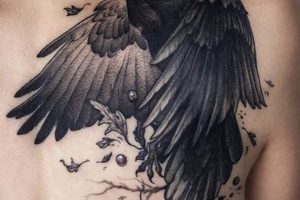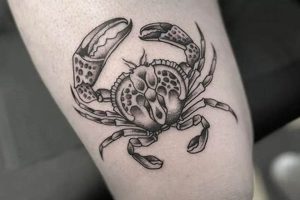Small, independent designs used to complement existing tattoos, connect disparate elements, or enhance overall visual appeal constitute a significant category within tattoo artistry. These designs, often geometric, floral, or abstract, can transform a collection of individual tattoos into a cohesive, flowing piece. For instance, small stars, dots, or geometric shapes can bridge the visual gap between larger, more prominent designs.
These complementary elements offer numerous advantages. They provide a solution for covering unwanted spaces or imperfections, allowing for greater flexibility in design placement and evolution over time. Historically, such filler elements have played a role in various tattoo traditions, from the intricate patterns of traditional Japanese tattooing to the decorative borders found in tribal styles. This historical context provides a rich source of inspiration for modern applications.
This exploration will delve into the various styles, motifs, and considerations involved in selecting and incorporating such complementary designs into existing or planned tattoo arrangements. It will also discuss the collaborative process between artist and client, and the factors that influence design choices.
1. Size and Placement
Size and placement are critical considerations when incorporating complementary tattoo elements. The effectiveness of these elements hinges on their ability to seamlessly integrate with existing tattoos. A filler element too large can overwhelm the main design, while one too small might appear insignificant or accidental. For instance, a delicate vine intended to connect two larger pieces would lose its impact if executed in thick, bold lines, potentially obscuring the primary artwork. Conversely, tiny dots intended to add shading might disappear against a backdrop of saturated color if not strategically clustered. Placement also dictates visual flow and balance. Filler elements should enhance, not disrupt, the overall composition. Careful placement can direct the viewer’s eye across the design, creating a cohesive narrative.
Consider a scenario where a client has a large floral tattoo on their shoulder and a smaller, unrelated design on their forearm. Connecting these two pieces requires careful consideration of size and placement. A thin, flowing vine with appropriately sized leaves could bridge the gap, while a series of small, strategically placed dots could create a subtle, yet effective connection. Alternatively, negative space can be just as impactful. Leaving areas intentionally blank can emphasize existing designs and provide breathing room, preventing a cluttered appearance. Understanding the interplay of positive and negative space is fundamental to achieving a balanced and harmonious composition.
Precise execution of size and placement requires a collaborative approach between the artist and the client. Open communication regarding desired aesthetics and long-term vision is crucial. Careful planning and consideration of these factors contribute significantly to the overall success and longevity of the tattoo. These seemingly small details ultimately dictate whether filler elements enhance or detract from the final artwork, transforming a collection of individual tattoos into a unified and aesthetically pleasing masterpiece.
2. Complementary Styles
Complementary styles are essential for successful integration of filler elements in tattoo design. The chosen style significantly impacts the overall cohesion and aesthetic of the final piece. A mismatch in styles can create a jarring visual effect, disrupting the intended flow and harmony. For instance, incorporating bold, traditional elements as fillers around a delicate, fine-line tattoo would likely clash, diminishing the impact of both styles. Conversely, selecting a complementary style allows the filler elements to seamlessly blend with the existing work, enhancing the overall composition. Dotwork, for example, can subtly complement geometric or mandala-inspired designs, while fine-line botanical elements can enhance floral pieces. The goal is to create a unified visual narrative where filler elements enhance, rather than detract from, the main design.
Consider a client with a Japanese-style dragon tattoo. Incorporating realistic portraits as fillers would create a stylistic conflict. However, using traditional Japanese waves, clouds, or cherry blossoms as fillers would maintain the overall aesthetic and enhance the narrative of the existing tattoo. Similarly, geometric patterns can complement geometric designs, creating a cohesive and visually appealing flow. Choosing a complementary style also allows for greater flexibility in design evolution over time. As clients add more tattoos, consistent stylistic choices ensure future additions integrate harmoniously.
Selecting a complementary style requires careful consideration of existing artwork, desired aesthetic, and the artist’s expertise. Understanding the nuances of various tattoo styles is crucial for both the artist and the client. This shared understanding facilitates effective communication and collaboration, leading to a cohesive and aesthetically pleasing result. The careful selection of complementary styles is therefore not merely an aesthetic choice, but a fundamental component of successful tattoo design, ensuring the longevity and visual appeal of the final piece.
3. Color coordination
Color coordination plays a crucial role in the effectiveness of gap filler tattoo elements. Harmonious color palettes create a sense of visual continuity, allowing filler elements to seamlessly integrate with existing tattoos. Conversely, poorly chosen colors can disrupt the overall aesthetic, making fillers appear disjointed and distracting. Consider a black and grey realism tattoo accented with brightly colored filler elements. The clash in color palettes would likely detract from the realism of the main piece, creating an unbalanced and visually jarring effect. However, using shades of grey or muted colors as fillers would maintain the cohesive aesthetic and enhance the overall impact of the design. Color theory principles, such as complementary, analogous, or triadic color schemes, provide a framework for effective color selection, ensuring visual harmony.
A practical example demonstrating the importance of color coordination involves a client with a traditional Japanese tattoo featuring koi fish. Introducing filler elements in contrasting colors, such as purple or green, could clash with the traditional orange, red, and black palette typically used in such designs. Instead, incorporating complementary shades of blue or accents of gold would enhance the visual appeal and maintain the traditional aesthetic. Furthermore, understanding color saturation and value allows for subtle shading and highlighting, creating depth and dimension within the filler elements themselves. This nuanced approach enhances the overall composition, making the filler elements integral to the design, rather than mere afterthoughts. Color coordination extends beyond individual elements, contributing to the overall visual flow and narrative of the tattoo as a whole.
Effective color coordination in gap filler tattoos requires careful planning and collaboration between the artist and client. Discussing color preferences, analyzing existing tattoos, and considering the long-term vision for the piece are essential steps. Challenges can arise when integrating filler elements into older tattoos where the original ink has faded or changed color over time. In such cases, color matching and correction become crucial aspects of the process. Ultimately, skillful color coordination elevates gap filler elements from simple space fillers to integral components of a cohesive and aesthetically pleasing tattoo composition.
4. Meaningful Motifs
Meaningful motifs elevate gap filler tattoos from purely aesthetic additions to deeply personal expressions. While simple geometric shapes or abstract patterns can effectively fill space, incorporating motifs imbued with personal significance adds depth and complexity to the overall design. This connection between personal narrative and visual representation transforms the tattoo into a powerful storytelling medium. Consider a client who wants to commemorate their love for nature. Instead of generic filler elements, incorporating small leaves, flowers, or animal silhouettes relevant to their personal experiences creates a more meaningful and resonant design. This approach not only enhances visual appeal but also imbues the tattoo with personal symbolism, strengthening the individual’s connection to the artwork.
The selection of meaningful motifs opens up a vast array of creative possibilities. Cultural symbols, spiritual icons, or elements representing hobbies and passions can be seamlessly integrated as filler elements. For instance, a music lover might incorporate small musical notes or instruments, while someone passionate about travel might choose miniature landmarks or compasses. These seemingly small details contribute significantly to the overall narrative of the tattoo, reflecting the individual’s identity and values. Moreover, meaningful motifs can create a sense of visual continuity across multiple tattoos, linking disparate designs through a common theme or symbolic thread. This allows for a cohesive and evolving narrative as the individual adds more tattoos over time, creating a rich tapestry of personal expression.
Integrating meaningful motifs requires thoughtful consideration and open communication between the artist and client. Understanding the client’s personal story, values, and aesthetic preferences is crucial for selecting appropriate motifs. The artist’s role extends beyond technical skill to encompass empathy and interpretive ability, translating personal narratives into compelling visual representations. Challenges can arise when trying to balance aesthetic considerations with symbolic meaning. Overly complex or numerous motifs can overwhelm the overall design, while poorly executed motifs can detract from the intended message. Therefore, careful planning and collaboration are essential for achieving a harmonious balance between visual appeal and personal significance, ensuring the final tattoo resonates with the individual on a deeper level.
5. Artist Collaboration
Artist collaboration forms the cornerstone of successful gap filler tattoo integration. Effective communication between artist and client ensures filler elements enhance, rather than detract from, the overall tattoo design. A collaborative approach allows the artist to understand the client’s vision, aesthetic preferences, and the existing tattoo’s narrative, leading to more cohesive and meaningful results. For instance, a client might envision delicate floral fillers, but the artist, with their expertise, could suggest incorporating elements from the existing tattoo’s style, resulting in a more harmonious composition. Conversely, without sufficient communication, filler elements might clash with existing designs, disrupting visual flow and undermining the intended aesthetic. Effective collaboration also addresses potential challenges, such as incorporating fillers into older, faded tattoos, requiring color matching and strategic placement.
The collaborative process extends beyond initial consultations. Artists provide valuable insights into size, placement, style, and color coordination, ensuring filler elements seamlessly integrate with existing work. This expertise proves particularly crucial when working with complex designs or covering unwanted elements. A skilled artist can strategically use filler elements to balance asymmetry, create visual transitions, or enhance specific features of the main tattoo. Real-life examples demonstrate this synergy: an artist might suggest using negative space as a filler element, emphasizing the existing design while avoiding visual clutter. Alternatively, they might recommend incorporating motifs that resonate with the client’s personal story, adding depth and meaning to the overall composition. This dynamic interplay between artistic expertise and client vision elevates gap filler elements from mere space fillers to integral components of a cohesive narrative.
Successful artist collaboration hinges on open communication, mutual respect, and a shared understanding of the desired outcome. Clients benefit from the artist’s technical expertise and aesthetic sensibilities, while artists gain valuable insights into the client’s personal narrative and vision. This synergistic relationship ensures gap filler elements not only enhance the aesthetic appeal of the tattoo but also deepen its personal significance. Challenges may arise due to differing aesthetic preferences or communication barriers, highlighting the importance of clear communication and a willingness to explore alternative solutions. Ultimately, effective artist collaboration ensures the longevity and artistic integrity of the tattoo, transforming a collection of individual elements into a unified and meaningful work of art.
Tips for Effective Filler Tattoo Integration
Strategic implementation of smaller design elements significantly impacts the overall cohesion and aesthetic impact of a tattoo. The following tips provide practical guidance for successful integration.
Tip 1: Plan Strategically: Avoid impulsive decisions. Thorough planning, including consultations with a reputable artist, is crucial. Consider the long-term vision for the piece, anticipating future additions and ensuring stylistic consistency.
Tip 2: Prioritize Cohesion: Filler elements should complement, not clash with, existing designs. Consider existing styles, color palettes, and overall themes to ensure seamless integration. A skilled artist can provide valuable guidance in achieving stylistic harmony.
Tip 3: Size and Placement Matter: The scale and positioning of filler elements significantly impact visual balance and flow. Smaller elements should enhance, not overwhelm, larger designs. Strategic placement can create visual connections and guide the viewer’s eye.
Tip 4: Embrace Meaningful Motifs: Incorporating elements with personal significance adds depth and complexity. Consider symbols, icons, or elements representing personal values, passions, or experiences to create a more resonant and meaningful design.
Tip 5: Color Coordination is Key: Harmonious color palettes create visual continuity. Consider existing ink colors, saturation levels, and color theory principles to ensure filler elements blend seamlessly, avoiding jarring contrasts or visual disruptions.
Tip 6: Research Artist Styles: Different artists specialize in various styles. Research portfolios to find an artist whose expertise aligns with the desired aesthetic for filler elements and existing tattoos. This ensures stylistic consistency and high-quality execution.
Tip 7: Communicate Effectively: Open communication with the chosen artist is paramount. Clearly articulate desired aesthetics, personal symbolism, and long-term vision for the tattoo. This collaborative approach ensures the artist understands and effectively translates the client’s vision.
Careful consideration of these tips significantly contributes to successful filler tattoo integration. These elements, when strategically implemented, enhance the overall composition, transforming individual tattoos into a cohesive and meaningful narrative.
This exploration of key aspects and practical tips provides a foundation for informed decisions and successful integration of filler elements, culminating in a cohesive and aesthetically pleasing tattoo design.
Frequently Asked Questions
This section addresses common inquiries regarding the integration of smaller, complementary tattoo designs.
Question 1: What are common design motifs used as filler elements?
Common motifs include geometric shapes, floral elements, dots, stars, and small animals. Selection depends on personal preference, existing tattoo styles, and desired aesthetic.
Question 2: How does one choose an appropriate size for filler elements?
Size should be proportionate to existing tattoos and the overall composition. Filler elements should enhance, not overwhelm, the main design. Consultation with a skilled artist helps determine appropriate scale.
Question 3: Can filler elements be used to cover unwanted tattoos or scars?
Yes, skilled artists can strategically use filler elements to camouflage unwanted areas. However, complete coverage may not always be possible, and consultation with an artist is crucial to assess feasibility.
Question 4: How painful is getting filler tattoos?
Pain levels vary based on individual tolerance, placement, and size of the filler elements. Generally, smaller designs are less painful than larger pieces. Discuss pain management options with the chosen artist.
Question 5: How much do filler tattoos typically cost?
Cost varies based on artist experience, design complexity, size, and placement. Obtain quotes from reputable artists to compare pricing and ensure alignment with budget.
Question 6: What is the healing process for filler tattoos?
Healing is similar to other tattoos, typically taking several weeks. Follow aftercare instructions provided by the artist to ensure proper healing and prevent complications.
Careful consideration of these frequently asked questions provides valuable insights for individuals exploring the integration of complementary tattoo designs.
Further exploration of specific styles and techniques provides a deeper understanding of the artistic possibilities.
Gap Filler Tattoo Filler Ideas
Strategic implementation of complementary tattoo designs necessitates careful consideration of various factors. Size, placement, style, color coordination, and meaningful motifs all contribute significantly to the overall aesthetic and personal resonance of a tattoo. Collaboration with a skilled artist remains paramount throughout the process, ensuring effective translation of individual vision into a cohesive and meaningful work of art. Effective planning, informed decision-making, and open communication are crucial for achieving desired results and ensuring the longevity of the chosen design.
The exploration of gap filler tattoo design reveals the potential for enhancing existing artwork and creating deeply personal narratives. Careful consideration of these elements elevates tattooing beyond mere aesthetics, transforming it into a powerful medium for self-expression and storytelling. The future of tattoo artistry lies in the continued exploration of innovative techniques and meaningful designs, empowering individuals to express their unique identities through the art of body modification.







